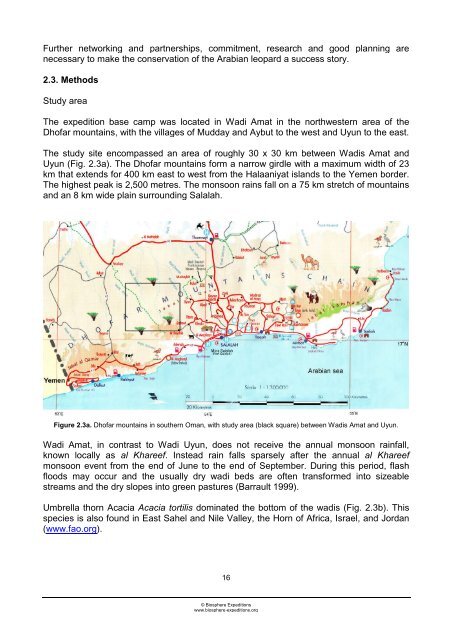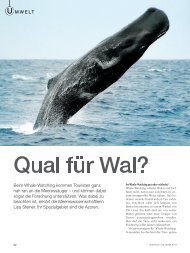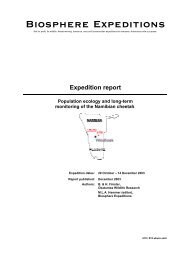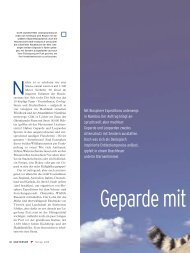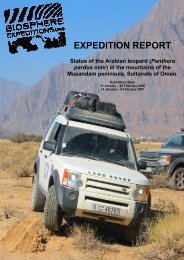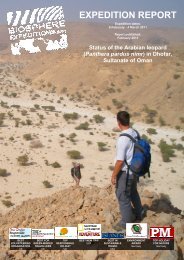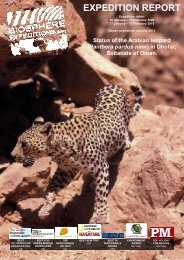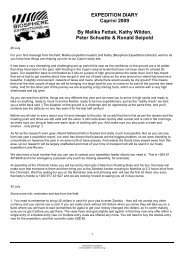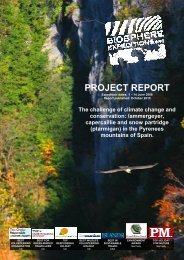Status of the Arabian leopard Panthera pardus nimr - Biosphere ...
Status of the Arabian leopard Panthera pardus nimr - Biosphere ...
Status of the Arabian leopard Panthera pardus nimr - Biosphere ...
You also want an ePaper? Increase the reach of your titles
YUMPU automatically turns print PDFs into web optimized ePapers that Google loves.
Fur<strong>the</strong>r networking and partnerships, commitment, research and good planning are<br />
necessary to make <strong>the</strong> conservation <strong>of</strong> <strong>the</strong> <strong>Arabian</strong> <strong>leopard</strong> a success story.<br />
2.3. Methods<br />
Study area<br />
The expedition base camp was located in Wadi Amat in <strong>the</strong> northwestern area <strong>of</strong> <strong>the</strong><br />
Dh<strong>of</strong>ar mountains, with <strong>the</strong> villages <strong>of</strong> Mudday and Aybut to <strong>the</strong> west and Uyun to <strong>the</strong> east.<br />
The study site encompassed an area <strong>of</strong> roughly 30 x 30 km between Wadis Amat and<br />
Uyun (Fig. 2.3a). The Dh<strong>of</strong>ar mountains form a narrow girdle with a maximum width <strong>of</strong> 23<br />
km that extends for 400 km east to west from <strong>the</strong> Halaaniyat islands to <strong>the</strong> Yemen border.<br />
The highest peak is 2,500 metres. The monsoon rains fall on a 75 km stretch <strong>of</strong> mountains<br />
and an 8 km wide plain surrounding Salalah.<br />
Figure 2.3a. Dh<strong>of</strong>ar mountains in sou<strong>the</strong>rn Oman, with study area (black square) between Wadis Amat and Uyun.<br />
Wadi Amat, in contrast to Wadi Uyun, does not receive <strong>the</strong> annual monsoon rainfall,<br />
known locally as al Khareef. Instead rain falls sparsely after <strong>the</strong> annual al Khareef<br />
monsoon event from <strong>the</strong> end <strong>of</strong> June to <strong>the</strong> end <strong>of</strong> September. During this period, flash<br />
floods may occur and <strong>the</strong> usually dry wadi beds are <strong>of</strong>ten transformed into sizeable<br />
streams and <strong>the</strong> dry slopes into green pastures (Barrault 1999).<br />
Umbrella thorn Acacia Acacia tortilis dominated <strong>the</strong> bottom <strong>of</strong> <strong>the</strong> wadis (Fig. 2.3b). This<br />
species is also found in East Sahel and Nile Valley, <strong>the</strong> Horn <strong>of</strong> Africa, Israel, and Jordan<br />
(www.fao.org).<br />
16<br />
© <strong>Biosphere</strong> Expeditions<br />
www.biosphere-expeditions.org


